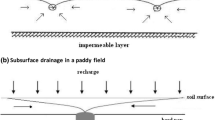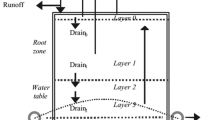Abstract
Subsurface drainage has been implemented in irrigation areas of South-eastern Australia to control water logging and land salinisation. Subsurface drainage has been identified as a major salt exporter from irrigated areas. The water table management simulation model DRAINMOD-S was evaluated to simulate daily water table depth, drain outflow, and salt loads by using experimental field data from a two year field trial was carried out in the Murrumbidgee Irrigation Area South-eastern Australia to study different options for subsurface drainage system design and management to reduce salt load export. Three subsurface drainage systems were modeled, deep widely spaced pipe drains, shallow closely spaced drains and deep pipe drains that were managed with weirs to prevent flow when the water table fell below 1.2 m. The reliability of the model has been evaluated by comparing observed and simulated values. Good agreement was found between the observed and simulated values. The model confirmed the field observations that shallow drains had the lowest salt load and that by managing deep drains with weirs salt loads could be significantly reduced. This work shows the value of the DRAINMOD-S model in being able to describe various drainage design and management strategies under the semi-arid conditions of South-eastern Australia. The model can now be used to investigate design and management options in detail for different site conditions. This will assist decision makers in providing appropriate subsurface drainage management policies to meet drainage disposal constraints within integrated water resources management planning.
Similar content being viewed by others
References
Armstrong AC, Mathews AD, Castle DA (1995) Drainage models to predict soil water regimes in drained soils: a UK perspective. Irrigation and Drainage System 9:205–215
Butler, BE (1979) A survey of the horticultural soils in the murrumbidgee irrigation areas, New South Wales. Bulletin No.289, CSIRO, Melbourne
Christen EW, Moll J (1996) Drainage systems for new vineyards on heavy clay soils. Farmers Newsletter, No. 180 Horticulture, September 1996
Christen EW, Skehan D (1999) Design and management of subsurface drainage for improved water quality: a field investigation. CSIRO Land and Water, Technical Report 6/99
Christen EW, Skehan D (May/June 2001) Design and management of subsurface horizontal drainage to reduce salt loads. ASCE Journal of Irrigation and Drainage Engineering 127(3):148–155
Cox JW, McFarlane DJ, Skaggs RW (1994) Field evaluation for predicting waterlogging intensity and drain performance in South-Western Australia. J Soil Res 32:653–61
Deverel SJ, Fio JL (1991) Groundwater flow and Solute movement to drain laterals, western San Joaquin Valley, California 1. Geochemical assessment. Water Resources Research 27(9):2233–2246
Grismer ME (May/June 1993) Subsurface drainage system design and drain water quality. Journal of Irrigation and Drainage Engineering 119(3)
Kandil HM (1992) DRAINMOD-S: A Water management model for irrigated arid lands. Ph.D. Thesis. North Carolina State University, Raleigh, USA
Kandil HM, Skaggs RW, Abdel-Dayem MS, Aiad Y, Gilliam JW (1992) DRAINMOD-S: water management model for irrigated arid lands, 1. theories and tests. ASAE Winter meeting, Paper No. 922566, Nashville, Tennessee.
Merz RD (1996) Application of DRAINMOD-S to irrigated semi-arid land in India. master thesis, department of biological and agricultural engineering, North Carolina State University, Raleigh, USA
Schaap MG (1999) Rosetta: a program for estimating soil hydraulic parameters. United States Salinity Laboratory, Riversode, CA. http://www.usssl.ars.usda.gov/models/rosetta/rosetta.htm
Skaggs RW, Fausey NR, Nolte BH (1981) Water management model evaluation for North Central Ohio. Transactions of ASAE, pp 922–928
Skaggs RW (1978) A water management model for shallow water table soils, water resources research institute. University of North Carolina, Report No. 134, Raleigh, USA
Skaggs RW (1991) Drainage. chapter 10, in: Hanks, J. and Ritchie, JT (editors), modeling plant and soil systems. Agronomy Monograph No. 31, ASA, Madison, Wisconsin, USA
Talsma T (1963) The control of saline groundwater. Meded Landbouwhogeschool, Wageningen 63(10):1–68
Van Genuchten M (1980) A closed form equation fro predicting the hydraulic conductivity of unsaturated soils. Soil Sci Soc Am J 44:892–898
Wahba MAS, El-Ganainy M, Abdel-Dayem MS, Kandil H, Gobran ATEF (2002) Evaluation of DRAINMOD-S for simulating water table management under semi-arid conditions. Irrigation and Drainage 51(3):213–226
Author information
Authors and Affiliations
Rights and permissions
About this article
Cite this article
Wahba, M.A.S., Christen, E.W. Modeling subsurface drainage for salt load management in southeastern Australia. Irrig Drainage Syst 20, 267–282 (2006). https://doi.org/10.1007/s10795-006-9007-x
Received:
Accepted:
Published:
Issue Date:
DOI: https://doi.org/10.1007/s10795-006-9007-x




